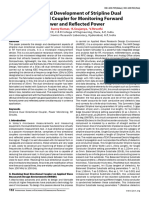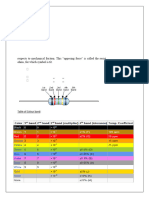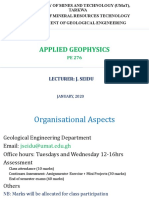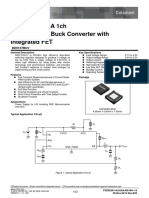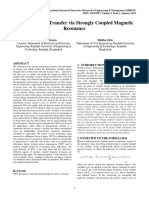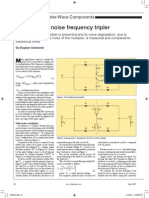Resistiivty Imaging Text PDF
Resistiivty Imaging Text PDF
Uploaded by
Sayed Jamaluddin HematCopyright:
Available Formats
Resistiivty Imaging Text PDF
Resistiivty Imaging Text PDF
Uploaded by
Sayed Jamaluddin HematOriginal Title
Copyright
Available Formats
Share this document
Did you find this document useful?
Is this content inappropriate?
Copyright:
Available Formats
Resistiivty Imaging Text PDF
Resistiivty Imaging Text PDF
Uploaded by
Sayed Jamaluddin HematCopyright:
Available Formats
Multi-electrode resistivity imaging for environmental and mining
applications
Jean Bernard, Orlando Leite, Fabrice Vermeersch
IRIS Instruments, Orleans, France
Summary
For a few years, the evolution of electronic components and of computer processing have
permitted to develop field resistivity equipment (SYSCAL Switch and SYSCAL Pro Switch units)
which includes a large number of electrodes located along a line at the same time, and which
carries out an automatic switching of these electrodes for acquiring profiling data.
The apparent resistivity pseudo sections measured with such a technique are processed by
an inversion software which gives interpreted resistivity and depth values for the anomalies
detected along the profile.
The multi-electrode resistivity technique consists in using a multi-core cable with as
many conductors (24, 48, 72, 96, …) as electrodes plugged into the ground at a fixed spacing,
every 5m for instance. In the resistivitymeter itself are located the relays which ensure the
switching of those electrodes according to a sequence of readings predefined and stored in the
internal memory of the equipment. The various combinations of transmitting (A,B) and receiving
(M,N) pairs of electrodes construct the mixed sounding / profiling section, with a maximum
investigation depth which mainly depends on the total length of the cable.
The 2D resistivity images obtained with such a multi-electrode technique are used for
studying the shallow stuctures of the underground located a few tens of metres down to about one
hundred metres depth; these images supply an information which complements the one obtained
with the more traditionnal Vertical Electrical Sounding (VES) technique, which mainly aims at
determining the depths of horizontal 1D structures from the surface down to several hundreds
metres depths.
Several examples are presented for various types of applications: groundwater (intrusion
of salt water in fresh water), geotechnics (detection of a fault in a granitic area), environment
(delineation of a waste disposal area) , archaeology (discovery of an ancient tomb) and mineral
exploration (detection of a metallic orebody).
Principle of multi-electrode resistivity imaging
For a few years, the evolution of electronic components and of computer processing have
permitted to develop field resistivity equipment (SYSCAL Switch and SYSCAL Pro Switch units)
which includes a large number of electrodes located along a line at the same time, and which
carries out an automatic switching of these electrodes for acquiring profiling data.
This technique, called Resistivity Imaging or Electrical Resistivity Tomography (ERT),
finds applications in the environment, groundwater, civil engineering and archaeology fields. The
images which are obtained (apparent resistivity pseudo sections) are processed by an inversion
software which gives interpreted resistivity and depth values for the anomalies detected along the
profile.
The multi-electrode resistivity technique consists in using a multi-core cable with as
many conductors (24, 48, 72, 96, …) as electrodes plugged into the ground at a fixed spacing,
every 5m for instance (Figure 1). In the resistivitymeter itself are located the relays which ensure
the switching of those electrodes according to a sequence of readings predefined and stored in the
internal memory of the equipment. The various combinations of transmitting (A,B) and receiving
(M,N) pairs of electrodes construct the mixed sounding / profiling section, with a maximum
investigation depth which mainly depends on the total length of the cable.
Figure 1 : SYSCAL Switch multi-electrode equipement
Various types of electrode combinations can be used, such as Dipole-Dipole, Wenner-
Schlumberger, Pole-Pole arrays. Each type of combination has advantages and limitations in terms
of lateral resolution and vertical penetration for instance, as summarized in Figure 2.
Arrays DIPOLE - DIPOLE WENNER - SCHLUMB POLE - POLE
Resolution best regular weak
Main Depth weak regular best
criteria Field set-up regular regular weak
Amplitude weak regular best
Other Natural noise regular regular weak
criteria Coupling noise best regular weak
A B M N A M N B B A M N
ϑ ϑ
a na a na a na a
CONFIGURATION
L L L
ESTIMATED about 0.9 x L
about 0.2 x L about 0.2 x L
INVESTIGATION DEPTH
Figure 2: Properties of electrode arrays
Depth of penetration in electrical imaging profiles
In electrical methods, the depth of penetration is linked to the distance between
electrodes. For a set of 48 electrodes spaced at 5m, two segments with 24 electrodes each are
usually used, the resistivitymeter being placed between both segments; the total length of the
cables is 240m. In a first approximation, for Dipole Dipole, Schlumberger and Wenner arrays, the
maximum depth of penetration is of the order of 20% of the total length of the cable, or 50m in the
present case. This depth is reached for the combination of the two extreme left and the two
extreme right electrodes of the profile, and the measuring report plotting point corresponds to the
bottom angle of the triangle of the pseudo section. For a Pole Pole array, where one current and
one potential electrodes are placed at infinity, this depth reaches 90% of the total length, or 220m
in the present case (Loke,
2000). station 1 station 1 station 2
segment a segment b segment a segment b
segment b segment a
1/2 Max
Max
Figure 3: Depth of penetration in multi-electrode resistivity measurements:
simple configuration (on left); roll along configuration (on right)
When the length of the profile to explore is greater than the length of the cable, after a first set of
readings taken at station 1 with the segments a and b, the operator has to move the first segment a after the
end of the second segment b and take a second set of readings at station 2 using segments b and a (see Figure
3), and so on, according to so called "roll along" sequences, until the end of the profile to investigate. It is
obvious from figure 3 that if the maximum depth reached for one single layout is "Max" at the extremity of
the triangle, it will be "Max/2" for two successive layouts (with roll along) for a flat bottom part of the
apparent resistivity image.
Acquisition time in multi-electrode imaging profiling
In such resistivity imaging techniques, the number of readings to take easily reaches several
hundreds, and the output power and output voltage of the equipment become important factors to limit the
number of stackings (repeated readings) necessary to reach a given quality of the measurements (which can
be represented by the standard deviation) and thus to minimize the acquisition time in the field.
In the past three years, multi-channel
units have been developed to measure
simultaneously several readings (up to ten with
the SYSCAL Pro Switch resistivitymeter), so
as to drastically reduce the total acquisition
time in such techniques. For instance, for a 48
electrode 5m spacing Pole Dipole array, a
required quality of 1% in a standard noise, a
100 ohm.m average resistivity and a 2.5 kohm
ground resistance, the duration of acquisition
of 500 readings is 25 minutes with a 600V
output voltage one channel unit (SYSCAL
R1Plus Switch 48), while it decreases down to
only 2minutes with a 800V output voltage ten
channel unit (SYSCAL Pro Switch 48). Such
new design of equipment makes nowadays
more realistic the acquisition of surface or
Figure 4 : SYSCAL Pro Switch, ten simultaneous channel
borehole 3D data, for a more precise multi-electrode resistivity system, with 250W , 800V and
description of the bodies responsible for 2.5A outputs
resistivity anomalies in environmental
applications.
The operating procedure in resistivity imaging techniques
The procedure for getting resistivity imaging includes the following four successive steps :
Creating the sequence of measurements with a PC software ; the sequence depends on the number of
electrodes, their spacing, the type of array (Schlumberger-Wenner, Dipole-Dipole, Pole Dipole, Pole Pole…),
the investigation depth to reach; loading of this sequence into the memory of the resistivitymeter.
Taking the readings in the field, after the electrode resistance checking, and the introduction of the stack
number which depends on the signal to noise ratio. During the measurements, the output voltage of the
equipment is automatically adjusted to the level of the signal measured.
Transferring the data from the memory of the equipment to a PC, filtering of noisy data in relation with
their standard deviation or on the level of the signal, introduction of the topography (electrode elevation),
visualization of the results by level of investigation depth.
Inverting the data with a PC 2D software, which, after a certain number of iterations, gives the values of the
interpreted resistivities (through a colour scale), and depths.
Examples of application of resistivity imaging for environmental studies
The multi-electrode resistivity imaging technique can be used in many applied geophysics domains
such as Hydrogeology, Geotechnics, Archaeology, Environment, Mining exploration
Hydrogeology: intrusion of salt water within sediments
depth (m) SAT WATER INTRUSION
SALT WATER SAND
SECOMA DATA
SAND / BASEMENT CONTACT sand Basement
resistivity in
ohm.m
Figure 5: Salt water resistivity imaging (Spain)
In the management of the coastal aquifers, the intrusion of salt water coming from the see
represents one of the major issues for the long term evolution of the fresh water resources. Through the
important contrast of resistivity between salt water and fresh water, resistivity imaging permits to follow the
limit between both types of waters at places where no drillhole is available. In the example of Figure 5
obtained in Spain (Wenner-Schlumberger array), salt water sands feature less than 1 ohm.m of interpreted
resistivity, while the non invaded zone gives more than 20 ohm.m.
Geotechnics: localization of a fault in a granitic area
Depth (m) FISSURED GRANITE
HARD GRANITE
ALTERED GRANITE
FRACTURE
Figure 6: Fault resistivity imaging (Spain)
In linear civil engineering works (roads, railways, …), the detection of geological structures gives
an important piece of information before control drillholes. In the example presented in Figure 6, a hard
granit area is characterized by a value of interpreted resistivity greater than 2000 ohm.m, while alteration is
under 200 ohm.m. A fault, clearly seen on the image separates both types of structures.
Environment: study of a waste disposal area
clay layer disposal area
Elevation (m)
440
420
clay layer
400
resistivity (ohm.m)
Figure 7: Waste disposal area resistivity imaging (France)
A new subject recently introduced in environmental projects is the control of waste disposal areas
with geophysical methods (Guerin et al., 2004). Resistivity methods offer a good opportunity for such
monitoring studies, as the resistivity contrast between the inside part of the disposals and the surrounding
geological formations is generally high due to the high conductivity of the organic materials (lixiviates): in
the example shown in Figure 7, these resistivities are respectively 10 ohm.m and 1000 ohm.m. Measurements
carried out on the surface of the area and repeated at time intervals of months will give an idea of the
evolution of the physico-chemical processes occurring in the wastes themselves.
Archaeology: detection of cavities close to the surface
depth
EXPECTED CAVITY
resistivity (ohm.m)
Figure 8: Cavity resistivity imaging (Middle East)
In civil engineering as well as in archaeology, the detection of cavities represents an important
activity. A cavity filled with air located above the water level appears as a resistive object with respect to the
surrounding formations. In the example of Figure 8, a set of 24 electrodes spaced at 3m has been used to
detect an ancient tomb located within the first four metres depth: its interpreted resistivity is greater than 2000
ohm.m, while the sand and gravel layers remain lower than 500 ohm.m.
Mining exploration: delineation of a metallic orebody
quartzites pelites Manganese limestones
~ 10 000 ohm.m ~ 1 000 ohm.m ~ 80 ohm.m ~ 5 000 – 200 ohm.m
100 1 000 10 000 ohm.m
Figure 9: Cavity resistivity imaging (South America)
In mining exploration, most of the orebodies appeared as conductive bodies and can be detected in
their more resistive background: in Figure 9, a Manganese orebody gives a conductive image of less than 100
ohm.m among quartzites, pelitic and limestones rocks of more than 1000 ohm.m. The 720m long profile has
been measured with a SYSCAL Pro Switch equipment with 72 electrodes spaced at 10m, in a Schlumberger-
Wenner configuration, with a measuring time of half an hour for the 2000 readings of the image.
Conclusions
The 2D resistivity images obtained with such multi-electrode techniques are used for studying the
shallow stuctures of the underground located a few tens metres down to about one hundred metres depth;
these images supply an information which complements the one obtained with the more traditionnal Vertical
Electrical Sounding (VES) technique, which mainly aims at determining the depths of horizontal 1D
structures from the surface down to several hundreds metres depths.
The newly developed multi-channel multi-electrode equipment will increase even more the field
efficiency for both 2D and 3D studies. The automatic processes in the acquisition and the inversion of the
data which simplify the work of the operators, but do not replace them for controling the quality of the
measurements and for managing the equivalence properties during the interpretation phase.
References
Guerin, R., Grellier, S., Robain, H., Bobachev, A., Vermeersch, F., 2004, Monitoring of a leakage
recirculation in a bioreactor by electrical resistivity tomography, EAGE Meeting, Paris
Loke, M. H., Electrical imaging surveys for environmental and engineering studies, a practical guide to 2D
and 3D surveys, 2000, geoelectrical.com
You might also like
- Depth of InvestigationDocument8 pagesDepth of InvestigationGogot Pantja Parijogo100% (1)
- WPS D1.3-2012 BlankDocument1 pageWPS D1.3-2012 BlankpjbedelNo ratings yet
- Product Brochure: Star Charge International BDDocument6 pagesProduct Brochure: Star Charge International BDFazrryMirzaNo ratings yet
- Depth of InvestigationDocument8 pagesDepth of InvestigationpokolokitoNo ratings yet
- DCResistivity Measurement PDFDocument52 pagesDCResistivity Measurement PDFHaritsari DewiNo ratings yet
- Unit IIDocument8 pagesUnit IIprajaktakumbhar41No ratings yet
- Operative Guide MultielectrodeDocument15 pagesOperative Guide Multielectroder5dvjr46c4No ratings yet
- PulsesDocument4 pagesPulsesshaniNo ratings yet
- Extended Analysis of Rectangular Microstrip Resonator AntennasDocument4 pagesExtended Analysis of Rectangular Microstrip Resonator AntennasGoudjil MohamedNo ratings yet
- MEDocument10 pagesMEShravani SurveNo ratings yet
- Design of Microstrip Antennas Covered With A Dielectric LayerDocument5 pagesDesign of Microstrip Antennas Covered With A Dielectric Layer하미드라힘No ratings yet
- Analytical Models For Low-Power Rectenna DesignDocument4 pagesAnalytical Models For Low-Power Rectenna DesignmoonyraNo ratings yet
- Wu 2017Document4 pagesWu 2017Moish KumarNo ratings yet
- Eddycurrentsensor PCB SENSOR 2010Document8 pagesEddycurrentsensor PCB SENSOR 2010Siphesihle NkosiNo ratings yet
- Rosell 2001Document11 pagesRosell 2001ionhandshakerNo ratings yet
- Dielectric Constant and Loss Tangent Measurement Using A Strigline FixtureDocument6 pagesDielectric Constant and Loss Tangent Measurement Using A Strigline FixtureLu LuNo ratings yet
- Design and Testing of A Diode-Based Electric Field Probe PrototypeDocument5 pagesDesign and Testing of A Diode-Based Electric Field Probe PrototypeHoracio DorantesNo ratings yet
- An Introduction To RF Anechoic Chamber TechnologyDocument81 pagesAn Introduction To RF Anechoic Chamber TechnologyasdsdNo ratings yet
- Particle-In-Cell Simulation of A Novel High Power Terahertz Vacuum Electron DeviceDocument6 pagesParticle-In-Cell Simulation of A Novel High Power Terahertz Vacuum Electron Deviceharun hakshiNo ratings yet
- Bonde PassantDocument6 pagesBonde PassantHoucine HoucineNo ratings yet
- 02 Tss Resist I VityDocument2 pages02 Tss Resist I VitygoomeyNo ratings yet
- TOMOGRAFO Design OF SENSOR ELECTRONICS FOR CACPACITANCE TOMOGRAPHY PDFDocument6 pagesTOMOGRAFO Design OF SENSOR ELECTRONICS FOR CACPACITANCE TOMOGRAPHY PDFVictor Jose BriceñoNo ratings yet
- Networks Impedance Coupling With One Stub.: Gallegos Santiago, Sambrano Yeslie, V Asquez Mar Ia FernandaDocument7 pagesNetworks Impedance Coupling With One Stub.: Gallegos Santiago, Sambrano Yeslie, V Asquez Mar Ia FernandaFercita VásquezNo ratings yet
- Microwave Planar Antenna DesignDocument57 pagesMicrowave Planar Antenna DesignMohamed Hussien HamedNo ratings yet
- Dual Directional Coupler Design Duroid 5880Document5 pagesDual Directional Coupler Design Duroid 5880PaulNo ratings yet
- Speaker Cables - AudioXpress - 504hansen1203Document11 pagesSpeaker Cables - AudioXpress - 504hansen1203caca recoNo ratings yet
- Predicting Radiated Emissions From Cables in The RE02/RE102/DO-160/SAE J113-41 Test Set Up, Using Measured Current in NEC and Simple TX EquationsDocument49 pagesPredicting Radiated Emissions From Cables in The RE02/RE102/DO-160/SAE J113-41 Test Set Up, Using Measured Current in NEC and Simple TX EquationsdasdfsadNo ratings yet
- 11L WaveguidesDocument52 pages11L WaveguidesGiovanni LorchaNo ratings yet
- A Low-Cost Vibrating Sample Magnetometry Based On Audio ComponentsDocument7 pagesA Low-Cost Vibrating Sample Magnetometry Based On Audio Componentsmarcos.robertoNo ratings yet
- Paper 2 Wavelet Analysis Based Scheme 1998Document8 pagesPaper 2 Wavelet Analysis Based Scheme 1998Umair MansoorNo ratings yet
- 2021IEEE57n2a5300305 - Development of A Broad Bandwidth Helmholtz Coil For Biomagnetic ApplicationDocument5 pages2021IEEE57n2a5300305 - Development of A Broad Bandwidth Helmholtz Coil For Biomagnetic Applicationf111142151No ratings yet
- kasai1982Document7 pageskasai1982katlina linNo ratings yet
- HIPOTESIS DeBROGLIEDocument4 pagesHIPOTESIS DeBROGLIEYusup SetiawanNo ratings yet
- Miniaturised Multi-Frequency Printed Circuit Antenna: Binay K. SarkarDocument50 pagesMiniaturised Multi-Frequency Printed Circuit Antenna: Binay K. SarkarNisha KumariNo ratings yet
- 6Document10 pages6sinanharamine546No ratings yet
- Encosure Amp Pier 2011Document16 pagesEncosure Amp Pier 2011Anonymous ZTD4CNkSkNNo ratings yet
- Characteristics of A Corrugated Tapered Slot Antenna With Dielectric Rod and Metallic Re EctorDocument4 pagesCharacteristics of A Corrugated Tapered Slot Antenna With Dielectric Rod and Metallic Re Ectorma_ba1No ratings yet
- Rectangular Waveguide ResonatorDocument18 pagesRectangular Waveguide ResonatorMilan MakwanaNo ratings yet
- All ExperimentsDocument157 pagesAll Experiments9b15rudra.keshNo ratings yet
- Corona Audible Noise of 110 KV High Voltage Overhead Transmission LinesDocument6 pagesCorona Audible Noise of 110 KV High Voltage Overhead Transmission LinesZoran PetrovićNo ratings yet
- TipfromTech DrivingLongCableLengthsDocument5 pagesTipfromTech DrivingLongCableLengthsHienNo ratings yet
- Transmission and Attenuation of Electromagnetic Pulses: Id: 004.pulses - Tex, V 1.35 2013/08/27 19:30:54 Spatrick ExpDocument4 pagesTransmission and Attenuation of Electromagnetic Pulses: Id: 004.pulses - Tex, V 1.35 2013/08/27 19:30:54 Spatrick ExpTulsiNo ratings yet
- A New Technology: For Measuring Overhead Line and Cable Impedance Values and The Ground Impedance of Large SubstationsDocument5 pagesA New Technology: For Measuring Overhead Line and Cable Impedance Values and The Ground Impedance of Large SubstationsJose Alberto RodriguezNo ratings yet
- Plasma-Diode ExperimentsDocument3 pagesPlasma-Diode ExperimentsjohnyredblueNo ratings yet
- AC ResistivityDocument6 pagesAC ResistivityJulio TedescoNo ratings yet
- Coil Material and Magnetic Shielding Methods For EfficientDocument11 pagesCoil Material and Magnetic Shielding Methods For EfficientAdhe MartiyaNo ratings yet
- Neukomm PDocument15 pagesNeukomm PDiego RodriguezNo ratings yet
- Noise Control in Strain Gage Measurements: Strain Gages and InstrumentsDocument8 pagesNoise Control in Strain Gage Measurements: Strain Gages and Instrumentsnsk143446No ratings yet
- Generalized Scaling Theory and Its Application To A Micrometer MOSFET DesignDocument11 pagesGeneralized Scaling Theory and Its Application To A Micrometer MOSFET DesignDinesh Reddy MaddeetiNo ratings yet
- Chapter 3 - Transmission Lines and Wave GuidesDocument37 pagesChapter 3 - Transmission Lines and Wave GuidesSomeoneNo ratings yet
- BroadBand Antennas and Traveling Wave AntennasDocument36 pagesBroadBand Antennas and Traveling Wave AntennasVeli100% (1)
- Chapter 3, Active RF Devices (Recap)Document63 pagesChapter 3, Active RF Devices (Recap)debdutt13No ratings yet
- Ispra 06 PDFDocument6 pagesIspra 06 PDFAhmad RiyandiNo ratings yet
- Electrical and Ccomputer Control Engineering Department AAST and Maritime Transport EgyptDocument6 pagesElectrical and Ccomputer Control Engineering Department AAST and Maritime Transport EgyptAhmad RiyandiNo ratings yet
- Measurement of Low Frequency Noise of MonocrystallDocument4 pagesMeasurement of Low Frequency Noise of MonocrystallJuan Marcelo ArgüelloNo ratings yet
- Applied Geophysics: Lecturer: J. SeiduDocument22 pagesApplied Geophysics: Lecturer: J. Seiduhenry christian wontumiNo ratings yet
- Lecture-12 - Introduction & Theoritical Background - Electrical MethodDocument22 pagesLecture-12 - Introduction & Theoritical Background - Electrical MethodNamwangala Rashid NatinduNo ratings yet
- AC Losses in High T Sub C SuperconductorsDocument6 pagesAC Losses in High T Sub C SuperconductorsJoseba BastarrarenaNo ratings yet
- An Experimental All-Band Nondirectional Transmitting Antenna - T2FDDocument2 pagesAn Experimental All-Band Nondirectional Transmitting Antenna - T2FDagressorbrNo ratings yet
- Analog Dialogue, Volume 48, Number 1: Analog Dialogue, #13From EverandAnalog Dialogue, Volume 48, Number 1: Analog Dialogue, #13Rating: 4 out of 5 stars4/5 (1)
- STEM: Science, Technology, Engineering and Maths Principles Teachers Pack V10From EverandSTEM: Science, Technology, Engineering and Maths Principles Teachers Pack V10No ratings yet
- Application MethodsDocument1 pageApplication MethodsSayed Jamaluddin HematNo ratings yet
- Resistiivty Imaging TextDocument2 pagesResistiivty Imaging TextSayed Jamaluddin HematNo ratings yet
- The Application of Borehole Logging To Characterize The Hydrogeology of The Faultless Site, Central Nevada Test AreaDocument46 pagesThe Application of Borehole Logging To Characterize The Hydrogeology of The Faultless Site, Central Nevada Test AreaSayed Jamaluddin HematNo ratings yet
- A Field Manual For Groundwater Sampling: Radu Boghici, P.G., Geologist March 2003Document47 pagesA Field Manual For Groundwater Sampling: Radu Boghici, P.G., Geologist March 2003Sayed Jamaluddin HematNo ratings yet
- QMC and Construction PartnersDocument1 pageQMC and Construction PartnersSayed Jamaluddin HematNo ratings yet
- PS 30 35 - 1Document5 pagesPS 30 35 - 1Sayed Jamaluddin HematNo ratings yet
- Geological Logging TableDocument4 pagesGeological Logging TableSayed Jamaluddin HematNo ratings yet
- Dora CC Mine LogDocument9 pagesDora CC Mine LogSayed Jamaluddin HematNo ratings yet
- CPTDocument21 pagesCPTSayed Jamaluddin HematNo ratings yet
- 04 4874C4spDocument310 pages04 4874C4spSayed Jamaluddin HematNo ratings yet
- How To Recondition A Car Battery at HomeDocument2 pagesHow To Recondition A Car Battery at HomePaulo Souza100% (2)
- 2.7V To 5.5V, 4A 1ch Synchronous Buck Converter With Integrated FETDocument25 pages2.7V To 5.5V, 4A 1ch Synchronous Buck Converter With Integrated FETRaguraman Bems - R&DNo ratings yet
- MM1431 Series: Precision Adjustable Shunt RegulatorDocument5 pagesMM1431 Series: Precision Adjustable Shunt RegulatorElec ThaihoaNo ratings yet
- Z170REG DatasheetDocument1 pageZ170REG DatasheetAutomation WorksNo ratings yet
- Analog Layout EngineerDocument4 pagesAnalog Layout EngineerAjay Kumar MattupalliNo ratings yet
- Radlay Automation - Product Catalogue-1Document16 pagesRadlay Automation - Product Catalogue-1mtanold13No ratings yet
- TX I O ModuleDocument9 pagesTX I O Moduleboat2639No ratings yet
- Syb Sicam Mic Eng PDFDocument92 pagesSyb Sicam Mic Eng PDFCune IonutNo ratings yet
- Mid 185 - Psid 2 - Fmi 3Document3 pagesMid 185 - Psid 2 - Fmi 3AkbarNo ratings yet
- Wireless Power Transfer Via Strongly Coupled Magnetic Resonances PDFDocument5 pagesWireless Power Transfer Via Strongly Coupled Magnetic Resonances PDFChandraNo ratings yet
- LG - VDE - NeON R - Installation ManualDocument12 pagesLG - VDE - NeON R - Installation ManualJacques BroadusNo ratings yet
- 04-Star Circuit V2Document2 pages04-Star Circuit V2anhufriendNo ratings yet
- MPPT Solar Charger Manual enDocument74 pagesMPPT Solar Charger Manual enjovan.englez1234No ratings yet
- Modelling of Transformer For SurgesDocument32 pagesModelling of Transformer For SurgesaocalayNo ratings yet
- Motor Starting CasestudyDocument2 pagesMotor Starting Casestudykajale_shrikant2325No ratings yet
- System Diagram Ec3000a 5r5 011 4 (Ups Epm S)Document24 pagesSystem Diagram Ec3000a 5r5 011 4 (Ups Epm S)Tuân HoàngNo ratings yet
- Ojacanje Spregnutih Nosaca Drvo-BetonDocument10 pagesOjacanje Spregnutih Nosaca Drvo-BetonMelihaNo ratings yet
- K - Factor EarthingDocument13 pagesK - Factor EarthingShrikant KajaleNo ratings yet
- Led Driver Catalog: Thomas Research ProductsDocument24 pagesLed Driver Catalog: Thomas Research ProductspabloNo ratings yet
- What Is Static ElectricityDocument8 pagesWhat Is Static ElectricityBrandon LeeNo ratings yet
- G5 Q3W6 DLL SCIENCE (MELCs)Document9 pagesG5 Q3W6 DLL SCIENCE (MELCs)REIANA MITZI M. FernandezNo ratings yet
- How To Create A Rechargable LED FlashlightDocument6 pagesHow To Create A Rechargable LED FlashlightManajanjimu ManNo ratings yet
- TI Space Products GuideDocument39 pagesTI Space Products GuideYze Shiuan YNo ratings yet
- LG SSS - BioLite - SolarHome620 v2 1Document2 pagesLG SSS - BioLite - SolarHome620 v2 1Mario AcostaNo ratings yet
- Electrical AccessoriesDocument80 pagesElectrical AccessoriesJuax Diesto100% (1)
- Solid-State vs. Magnetron Radar - RADA USADocument5 pagesSolid-State vs. Magnetron Radar - RADA USAstaff officerNo ratings yet
- Flexible Circuits Manufacturing GuideDocument66 pagesFlexible Circuits Manufacturing GuideSelvakumar NatarajanNo ratings yet
- Frequency TriplerDocument5 pagesFrequency Triplerchocobon_998078100% (1)
























